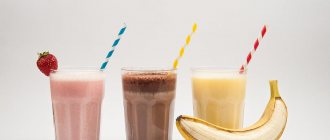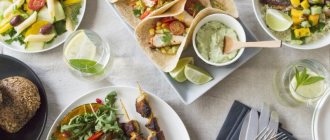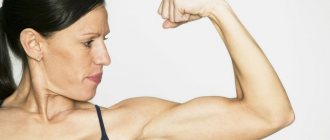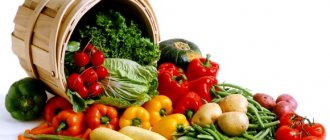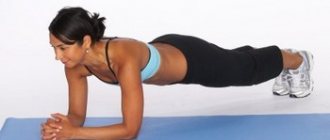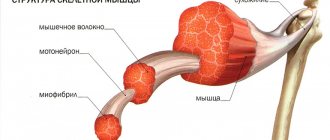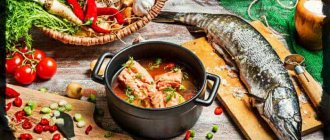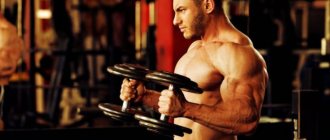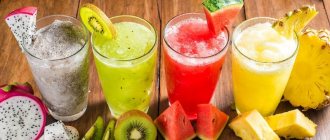Nutrition standards
For many athletes, both beginners and sometimes experienced ones, the problem of choosing the most healthy foods and dishes for their diet is pressing.
From an energy point of view, the nutritional norm of an average adult is in the region of 3-3.5 thousand kcal, depending on the type of activity. But for athletes trying to gain weight, or actively training before competitions, this norm is in the region of 4 thousand kcal, and can reach up to 5. Of course, not everyone can get this amount of calories from regular food, especially since the athlete needs not only calories as such, but also a balanced set of nutritional components: proteins, fats, carbohydrates, fiber, vitamins, minerals, etc.
To get additional calories (and, for example, protein), you can use sports nutrition, say a protein shake. But with ordinary food, which forms the basis of the diet, you need to figure it out. You should only include in your menu those dishes that are prepared from the best products that are optimal from the point of view of sports. We will look at products suitable for fitness and bodybuilding, collecting them into 4 groups: sources of protein, carbohydrates, fats and vitamins.
Beans in bodybuilding
MACRONUTRIENTS
| 100 g of beans contains the following macronutrients: Carbohydrates: 60 g , of which: dietary fiber – 20-25% starch – 70-75% sugar – 5%. Proteins: 21-23 g , of which: the number of essential amino acids – 12 the number of non-essential amino acids – 8 leader amino acids – glutamic acid, aspartic acid, leucine BCAA amino acids – 18% Fat: 0.8-1.7 g , of which: Unsaturated (useful) – 70% Saturated – 30% |
| ENERGY VALUE |
| 100 g of peas contains 280-300 kcal |
| GLYCEMIC INDEX |
| The GI of beans is low: from 15 to 35 depending on the variety. The GI of canned beans is medium-high - about 70. |
| PROPERTIES |
Benefit:
Harm:
|
| WEIGHT MEASURES |
| One faceted glass (200 ml) holds 175 g of beans. |
1 comment on the post “BEANS”
harm (more precisely, unpleasant “side effects”) are described incorrectly. 1. beans do not increase acidity. 2. beans do not contain dietary fiber (cake) more than potatoes and cereals. On the contrary, bean grain is very concentrated in proteins and carbohydrates. The problem is the composition of both. The amino acid profile of all legumes is incomplete, but can be easily corrected by combination with the fermented milk profile. But the proteins themselves of all legumes are difficult to digest, and for better absorption they need to be cooked for a long time (that is, denatured)... There is the same problem with carbohydrates - or rather, only with one (stachyose) - and the standard starch in beans is up to half the weight. Stachyosis, on the other hand, is not broken down by human enzymes, it only irritates the intestinal walls, but the microflora breaks it down easily, but does not utilize it 100%, but with large losses in the form of gaseous “waste”. Depends on the individual microflora. But to minimize harm, it is advisable to soak the beans in cold water and drain the water before cooking (1-3 times). True, along with stachyose, half of the K+ ions and glucose will pass into the water.
The best protein foods
Meat is the main source of protein, despite the fact that there are products with the same or even higher protein content (nuts, fish, shrimp and squid, cottage cheese, cheese, beans, peas, soy, etc.). In terms of the amount of protein among different types of meat, the leaders are beef, horse meat, rabbit, turkey and chicken. However, it is recommended to eat lean meat, such as chicken breast. It is important to keep in mind that red meat contains creatine, which is beneficial for athletes.
Fish and seafood contain almost more protein than meat; in addition, fatty fish can also be eaten, since fish oil, unlike pork or beef, is better and faster absorbed and contains polyunsaturated fatty acids (omega-3) , less bad cholesterol and has a number of other beneficial properties. Pink salmon, halibut, saury, salmon, river perch, carp and tuna, as well as squid and shrimp (especially Far Eastern) contain the most protein.
Eggs are easier to digest than meat and contain a lot of protein (although less than meat and fish). Soft-boiled eggs are best digested. Eating raw eggs is not recommended, and you should also not eat a lot of egg yolks, as they are believed to increase cholesterol levels. If you have to eat a lot of eggs, use mostly whites.
Cottage cheese and other dairy products contain a lot of protein. The healthiest thing is low-fat cottage cheese. Low-fat dairy products, such as fermented baked milk, yogurt, kefir, also contain a lot of protein. There is a lot of protein in cheeses, but they also have a lot of fat, so it is better to choose low-fat cheeses (such as feta cheese).
Legumes - beans, beans, soybeans, peas, lentils, etc. - contain a lot of protein, more than meat. If for some reason you are forced to limit your meat consumption, your body’s protein needs can be successfully compensated for by boiled beans (beans) or peas.
Nuts are another great source of protein. Peanuts have the most protein. It is followed (in descending order) by sunflower seeds, almonds and hazelnuts. You just need to remember that nuts contain a lot of fat - for example, more than 50% in seeds. Therefore, you should not consume kilograms of nuts - a handful of nuts a day is enough. It is also important to remember that some people are allergic to peanuts (and other nuts).
Sweets
Sweetening is a big no-no after training, as it leads to a sharp surge in energy, followed by an equally sharp drop. This means you should avoid processed sugars found in sweets at all costs. They do not contain important nutrients your body needs to get enough energy.
Best Sources of Carbohydrates
Porridge is an excellent source of carbohydrates. Moreover, it is important that cereals contain not only carbohydrates, but also protein (especially oatmeal, buckwheat, wheat groats, semolina, millet, pearl barley), as well as dietary fiber (fiber), which improves intestinal function. The amount of carbohydrates in various cereals varies from 65 to 75%. Interestingly, the type of grain processed can change the type of carbohydrates and glycemic index of the finished dish. For example, whole grain oatmeal (Hercules) has a low glycemic index, unlike instant oatmeal.
Noodles and pasta, especially those made from durum wheat and wholemeal flour. Adding vegetables high in fiber (lettuce and other greens, cabbage, green beans, etc.), as well as protein products (eg, meat sauce) lowers the glycemic index of the dish because it slows down the absorption of carbohydrates. In general, it is worth keeping in mind that eating vegetables and grains that contain fiber is useful for losing weight, but due to the slower absorption of carbohydrates and proteins, it may not be appropriate for gaining muscle mass.
Vegetables such as potatoes and beets also contain a lot of carbohydrates, and these are mainly quickly absorbed carbohydrates. You should not overuse fried vegetables - baked or boiled in their jackets are best.
Fruits and dried fruits, such as bananas, dates, dried apricots, figs, prunes, raisins, are simply a storehouse of simple carbohydrates, as well as microelements and vitamins. They can be eaten plain (or mixed with nuts), and added to porridge and other dishes.
Heavy proteins such as steak
As with spicy foods, you need to avoid anything that will be difficult to digest and assimilate, including steak. If you plan to gain muscle mass, you should add as many carbohydrates as possible by including tuna rice in your diet, for example. If you want to lose weight, you should give up carbs and drink a protein shake to maintain the existing muscles.
Best Sources of Fats
Vegetable oils are all easier to digest and healthier for the body than animal fats. It is advisable not to fry in oil, but to add it to ready-made dishes (for example, porridge or salad), since heat treatment of oils greatly accelerates the oxidation of fatty acids and the formation of various harmful substances. Unfortunately, Omega-3 fatty acids, the most beneficial for the body, oxidize extremely quickly, so if you buy flaxseed or camelina oil, be sure to pay attention to the expiration date (the fresher the oil, the better), the light protection of the container (a dark brown bottle is better everything), and do not subject it to heat treatment under any circumstances.
Fish and fish oil - as already mentioned, contain a large amount of unsaturated fatty acids, which are easily digestible and accelerate metabolic processes, as well as contribute to more active processing of adipose tissue by the body and improvement of the cardiovascular system. Most Omega-3 polyunsaturated fatty acids are found in tuna, Atlantic salmon, Atlantic herring, trout, sardines, carp and salmon.
Nuts and seeds - we have already mentioned as an excellent source of vegetable fats. They also contain a lot of protein and very few carbohydrates. In addition, nuts contain a large amount of microelements (magnesium, potassium, zinc, iron, calcium).
Avocado is a very healthy vegetable, containing a large amount of vegetable fats and microelements.
Smoothies from ready-made powders
They can be extremely convenient, especially if you're short on time and need to quickly prepare something after a workout, but in most cases they contain an impressive amount of added sugar. Your body burns complex carbohydrates first, and only then fats. If you drink sugary drinks, you will slow down your fat burning process.
Sources of vitamins
Fruits first. Citrus fruits, kiwi, apples, and cranberries especially contain vitamin C. Apricots are rich in potassium and magnesium, while pomegranates contain large amounts of iron.
Fresh vegetables - tomatoes, carrots, spinach - are rich in antioxidants, carotenes, and tomatoes are a storehouse of lycopene.
Onions, garlic and herbs are the richest source of a number of essential microelements, vitamins, antioxidants, phytoncides and other substances. They help to cope with stress (and every hard workout is stress for the body), increase the body’s resistance and endurance, strengthen the immune system and have a number of other beneficial effects on the athlete’s body.
Sports drinks
These drinks are marketed as ideal for hydrating your body after exercise because they contain electrolytes, so why might they be a bad option? The high sugar content of these drinks makes them unnecessary after a workout because your body doesn't need the extra glucose in your bloodstream.
The star of the series “Sultan of My Heart” spoke about the choice of his future wife
25 children of a childless man: an extraordinary reunion
Smooth armpits without shaving: ways to remove hair using conventional products
Benefit
Fruits are a storehouse of vitamins and minerals. By replenishing beneficial nutrients, they support health, which is extremely important for regular training.
Due to their high fructose content and fast carbohydrates, they instantly satisfy the feeling of hunger. This can be useful if an athlete has missed a meal and needs a boost. In addition, these components increase energy potential, restore glycogen levels and suppress the feeling of fatigue.
Many fruits have an antioxidant effect. This protects nitric oxide from the negative effects of radicals, improves muscle condition, immune system function, and also prolongs youth. They also lower cholesterol levels and minimize the risk of blood clots and cholesterol plaques.
